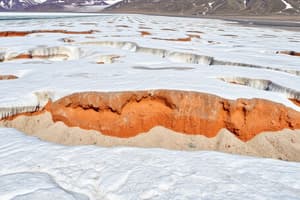Podcast
Questions and Answers
What conditions are necessary for a glacier to form?
What conditions are necessary for a glacier to form?
More snow must fall in winter than melts in summer, leading to an accumulation of snow and ice over time.
How does glacial erosion transform a pre-existing V-shaped valley?
How does glacial erosion transform a pre-existing V-shaped valley?
Glacial erosion widens and deepens the valley, creating a U-shaped cross-section with steep sides and a flat floor.
What is the main difference between a U-shaped valley and a V-shaped valley?
What is the main difference between a U-shaped valley and a V-shaped valley?
A U-shaped valley is formed by glacial erosion, while a V-shaped valley is formed by river erosion.
How does a hanging valley form in relation to the main glacial valley?
How does a hanging valley form in relation to the main glacial valley?
What processes contribute to the formation of a corrie (cirque)?
What processes contribute to the formation of a corrie (cirque)?
How does a pyramidal peak form in a glacial landscape?
How does a pyramidal peak form in a glacial landscape?
What is an arête, and how is it formed?
What is an arête, and how is it formed?
What is a moraine in the context of glacial deposits?
What is a moraine in the context of glacial deposits?
What is the primary difference between glacial erosion and river erosion in shaping valleys?
What is the primary difference between glacial erosion and river erosion in shaping valleys?
How does the accumulation of snow in a corrie contribute to glacial erosion?
How does the accumulation of snow in a corrie contribute to glacial erosion?
Flashcards are hidden until you start studying
Study Notes
Types of Moraines
- Lateral Moraine: Forms along the sides of a glacier, composed of debris accumulated as the glacier advances.
- Terminal Moraine: Created at the furthest point reached by a glacier, marking the maximum extent of its advance.
- Ground Moraine: A layer of till deposited beneath a glacier, resulting from the movement and melting of the glacier.
Drumlin
- A streamlined hill of glacial till that is elongated in shape, indicating the direction of glacial movement.
- Typically found in clusters known as drumlin fields, showcasing patterns of past glacier flow.
Erratic Rocks
- Large boulders, varying in composition from local geology, are transported and deposited by glaciers.
- Their presence often signifies considerable glacial transport, appearing far from their origin.
How Glaciers Work
Erosion
- Glaciers are significant agents of landscape alteration, functioning through abrasive processes like plucking and freeze-thaw weathering.
Abrasion
- Involves debris and rocks embedded in the glacier grinding against the bedrock, smoothing it and creating striations and rock flour.
- Most effective when the glacier contains abundant debris.
Plucking
- Occurs when glaciers freeze onto rocks, pulling them from the bedrock as they advance.
- Results in a rugged terrain featuring jagged landscapes and contributes debris to the glacier.
Freeze-Thaw Weathering
- Water infiltrates rock cracks, freezes, and expands, causing the rock to fracture.
- Significant in high-altitude and polar regions with fluctuating temperatures.
Transport
- Glaciers move vast amounts of debris and rocks over extensive distances, incorporating materials from rockfalls and wind-blown sediment.
- Surface debris travels with the glacier, while internal layers may be buried or fallen into crevasses.
- Base debris grinds against underlying bedrock, aiding erosion.
Deposition
- Melting glaciers release carried debris, forming distinct landforms and features such as moraines.
Till
- Represents unsorted glacial debris and sediment deposited directly by melting glaciers, contributing to geomorphological features.
Moraines
- Form distinct ridges or mounds composed of till created during glacial movement, which can be lateral, medial, terminal, or ground.
Glacial Landforms
U-Shaped Valley
- Characterized by a flat floor and steep sides, created as glaciers widen and deepen pre-existing V-shaped valleys through erosion.
V-Shaped Valley
- Formed by river erosion, featuring steep sides and a narrow valley floor distinct from U-shaped valleys.
Hanging Valley
- A tributary valley that meets a main glacial valley at a height, often resulting from less erosion by smaller glaciers.
Corrie (Cirque)
- An amphitheater-like hollow at glacier heads formed through erosion and freeze-thaw weathering, serving as the accumulation zone for snow and ice.
Pyramidal Peak
- A sharply pointed peak created by the erosion of multiple corries around it, characterized by several arêtes radiating outward.
Arête
- A sharp, narrow ridge formed between two adjacent glacial valleys, shaped by the erosive power of glaciers on either side.
Glacial Deposits
- Moraine: An accumulation of unsorted glacial debris (till) deposited by glaciers, forming distinct landforms and features in the landscape.
Studying That Suits You
Use AI to generate personalized quizzes and flashcards to suit your learning preferences.




